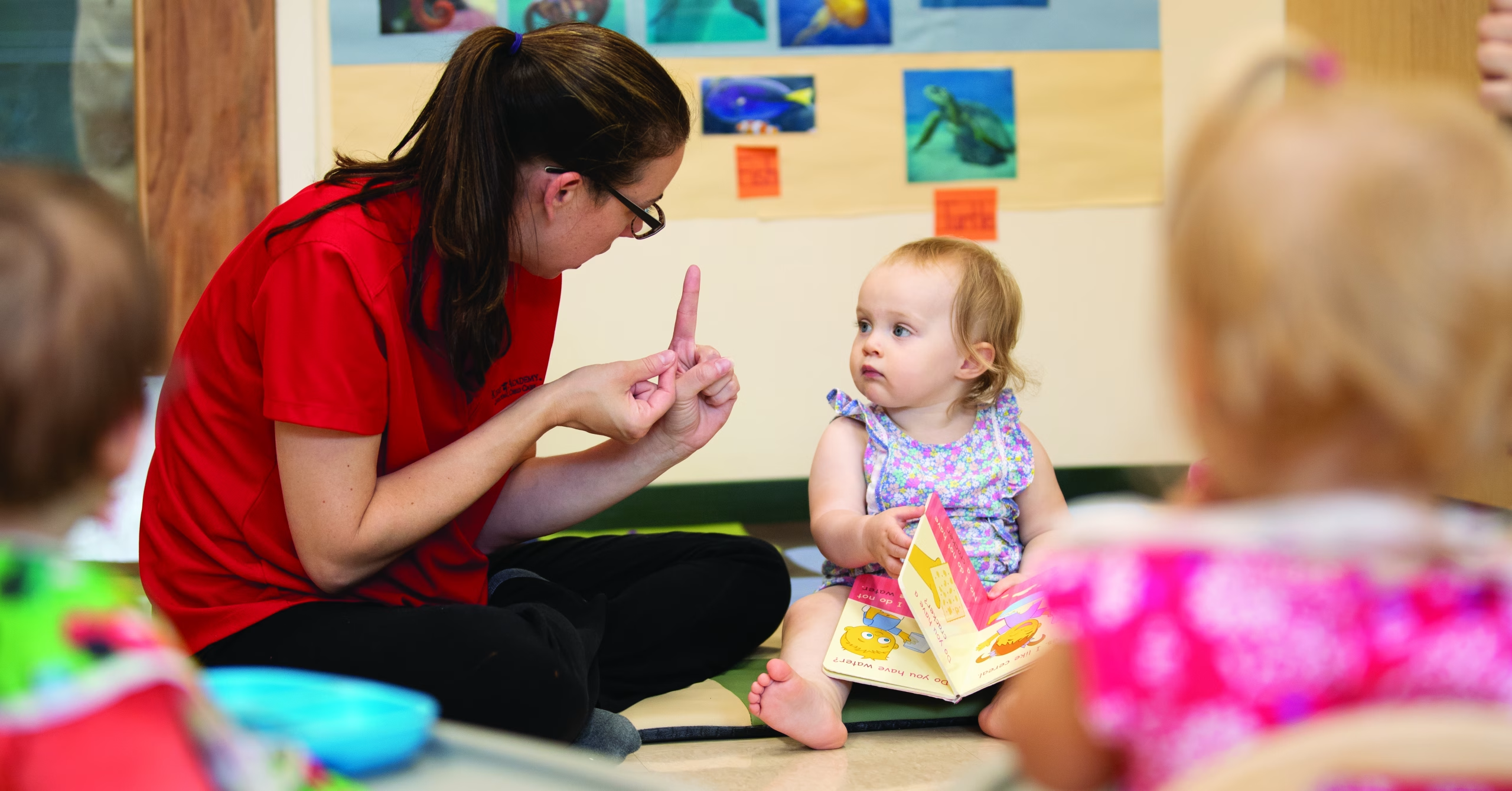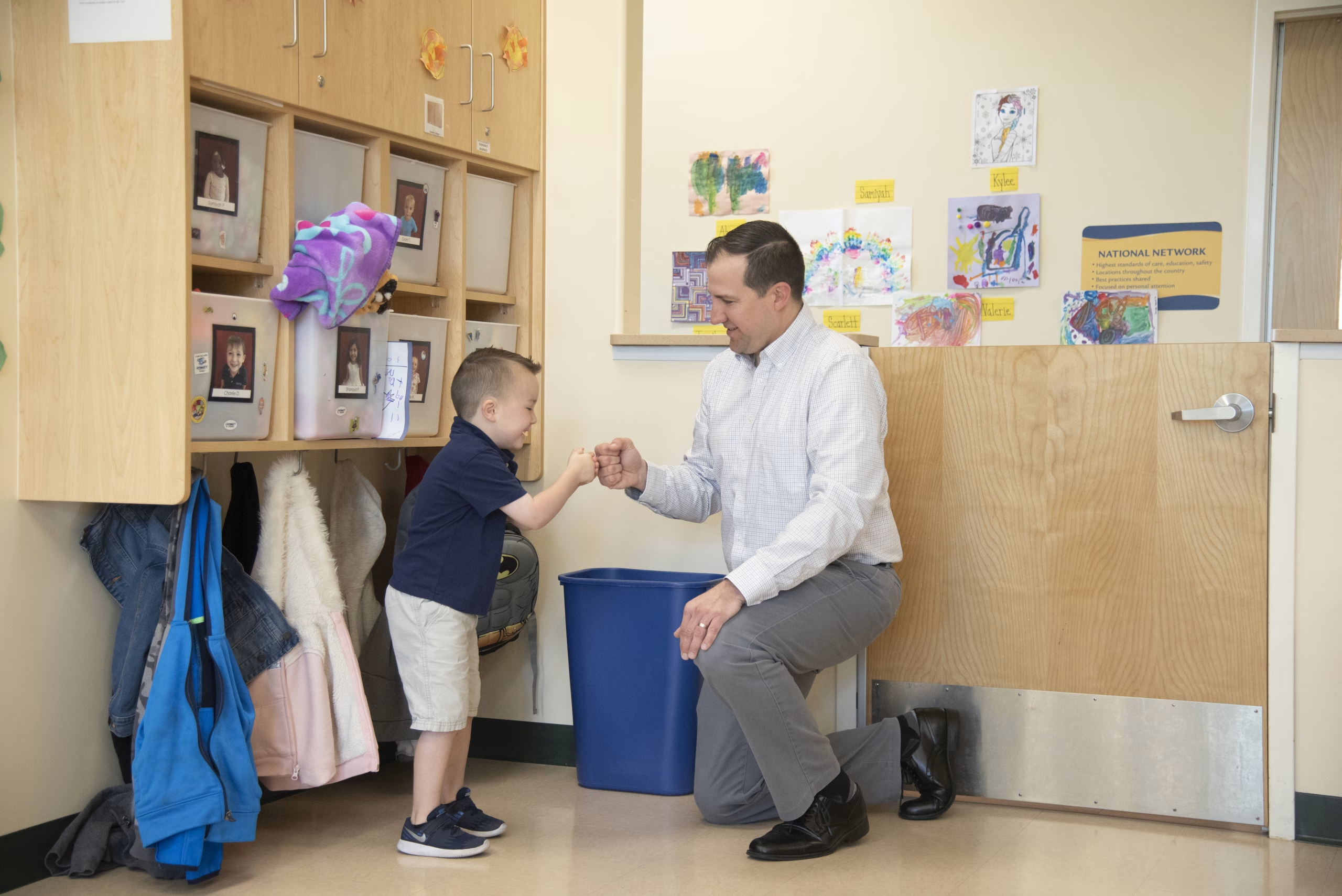
When we think of sign language, we typically associate it with non-verbal or non-hearing people, but did you know it has benefits for all children?
Visual language allows communication to start earlier through hands, shapes, movements, and facial expressions. This gives families and educators the opportunity to better understand a child’s needs at a younger age, creating a strong foundation for the future. But that’s not all. Teaching sign language, particularly to infants and toddlers, can also have an incredibly valuable impact on language, cognitive, and social-emotional development.
Language Development
We know simply from observing infants and toddlers that they naturally use their hands to communicate when they talk. For example, they might flail their hands to express frustration or excitement, or reach out to show that they’re curious about something. Research shows that building on this and using it as an opportunity to teach sign language often results in children having bigger vocabularies and using longer sentences as they get older. When children who were taught sign language at 11 months old were compared to a group of children who had not been taught sign language, it was clear those children had more developed language skills. They were able to understand more words from the time they were 15 months old and were using more words and longer sentences from two to three years old [4]. Another study also uncovered that sign language can help initiate learning words. Each time children who participated in the study were taught a sign for a certain concept, they were able to learn and understand the verbal word shortly thereafter. [5]
Cognitive Development
There have been many claims, especially in the last decade, that sign language can facilitate communication between adults and children and as a result, higher levels of cognitive development. When a group of children were observed and tested by researchers Linda Acredolo and Susan Goodwyn, they found that children who were taught sign language at 11 months old scored an average of 12 points higher on a second grade IQ test than children who were not taught sign language. [7] This further validates the idea that teaching sign language at a young age has a remarkable long-term impact.
Social-Emotional Development
Communication is often considered the foundation of healthy relationships. Teaching sign language at a young age gives children who can’t yet speak the opportunity to express themselves without words. It allows them to properly share their wants and needs without getting frustrated that their parent or teacher doesn’t understand. In fact, studies show that children who were taught sign language have fewer tantrums and better social skills [8]. They also tend to have an easier time controlling their own behavior and coping with stressful situations such as school drop-offs. [11]
With so many valuable benefits, we would be remiss not to integrate sign language into our Life Essentials® curriculum for infants. Some examples of how our educators might do this include:
- Introducing daily routine words such as: “eat,” “more,” “please,” and “thank you” and signing the word each time they say it aloud. Then, prompting the child to use the sign to signal what they want or need.
- Picking out a favorite song with a child and learning how to sign parts of it to include as they sing it aloud.
- Observing when a child is hungry, tired, or wants to play and using signs to verbalize the observations. This might include asking, “What’s the matter? Do you want me to play with you? What shall we play?” and then performing the sign for the word “play” each time you say it.
Teaching sign language in the early stages of your child’s life can have a profound effect on their ability to thrive later. If you’re interested in learning more about our curriculum and how we integrate sign language, visit our website or schedule a tour.
References
1. Vallotton, C., Signs of emotion: What can preverbal children “say” about internal states? Infant Mental Health Journal, 2008. 29: p. 234-258.
2. Vallotton, C., Sentences and conversations before speech? Gestures of preverbal children reveal cognitive and social skills that do not wait for words, in Integrating Gesture: The Interdisciplinary Nature of Gesture, G. Stam & M. Ishino, Editors. 2011, John Benjamins: Amsterdam, The Netherlands. p. 105-120.
3. Kelly, S., T. McDevitt, and M. Esch, Brief training with co-speech gesture lends a hand to word learning in a foreign language. Language and Cognitive Processes, 2009. 24(2): p. 313-334.
4. Goodwyn, S., L. Acredolo, and A.L. Brown, Impact of symbolic gesturing on early language development. Journal of Verbal and Nonverbal Behavior, 2000. 24(2): p. 81-103.
5. Vallotton, C.D., K.B. Decker, and M. Fusaro. A bridge to somewhere: Symbolic gestures as concrete representations that build towards abstract ones, in XVIIth Biennial International Conference on Infant Studies. 2010. Baltimore, MD.
6. Xu, J., et al., Symbolic gestures and spoken language are processed by a common neural system. Proceedings of the National Academy of Sciences, 2009. 106(49): p. 20664-20669.
7. Acredolo, L. and S. Goodwyn, The long-term impact of symbolic gesturing during infancy on IQ at age 8, in International Society for Infant Studies. 2000: Brighton, U.K.
8. Acredolo, L. and S. Goodwyn, Baby Signs: How to Talk with Your Baby Before Your Baby Can Talk. 2002, Chicago: Contemporary Books.
9. Gongora, X. and C. Farkas, Infant sign language program effects on synchronic mother-infant interactions. Infant Behavior & Development, 2009. 32: p. 216-225.
10. Vallotton, C., Infant signs as Intervention? Promoting symbolic gestures for preverbal children in low-income families supports responsive parent-child relationships. Early Childhood Research Quarterly, in press.
11. Vallotton, C., Infants take self-regulation into their own hands. Zero To Three, 2008. 29: p. 29-34.





